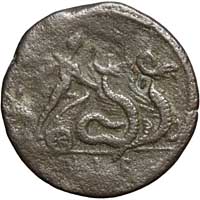 |
| Bronze coin of Gordian III from Hadrianopolis showing Demeter in her chariot. |
Another new ancient coin, bought not because of any particular artistic merit but because of its subject. This is the Greek goddess Demeter, whose myth originated agriculture and the seasons. Her daughter Persephone was kidnapped by Hades and taken to his dark underworld to be his wife.
Hades was a powerful god, one of three brothers who shared the whole world between them - the others being Zeus, who ruled the land surface, and Poseidon, god of the sea.
 |
Bronze drachm of Trajan
showing Triptolemos distributing wheat. |
Demeter was distraught at the loss of her daughter. She took her carriage, drawn by two Drakones, large winged snakes, and carrying two torches to light her way she searched everywhere. Her search is depicted on this coin.
Don't be distracted by the way the coin seems to say "PIANO". That's part of the name of its town of origin, in Greek lettering: AΔPIANOΠOΛEITΩN, meaning "from Hadrianopolis."
Demeter later lent the same carriage to her foster son Triptolemos, and some coins show him on his mission to distribute wheat and the knowledge of agriculture throughout the world. Here's one, this time from Alexandria. He is holding up a fold of his cloak so that it can hold the grain, and flinging it out with his right hand.
In some vase paintings, the chariot itself is winged, and is drawn by more ordinary snakes.
The Roman equivalent of Demeter was the goddess Ceres, from whose name we get the word "cereal."
























